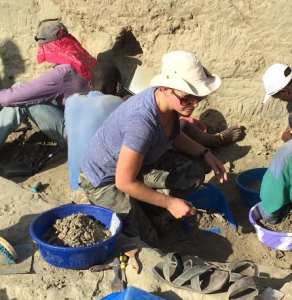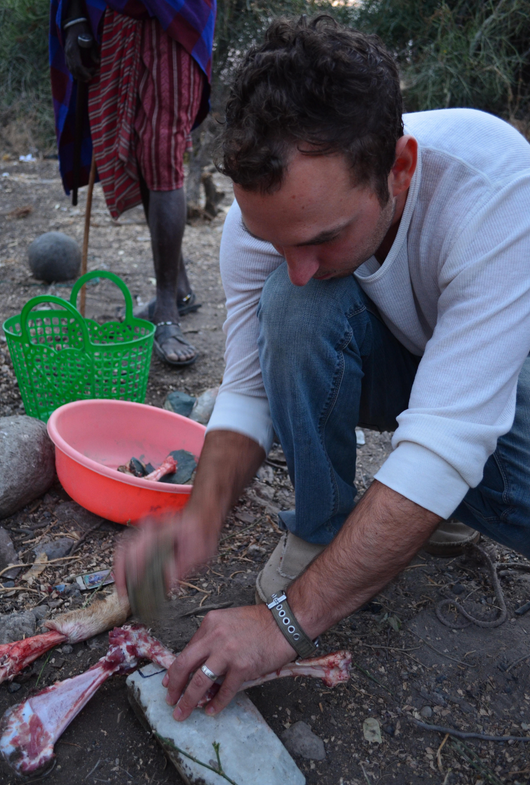
A Colorado State University graduate student recently had the rare opportunity to work at an archeological site that is considered one of the world’s most important to the study of human evolution.
Kristen Welch, a master’s student in the CSU Department of Anthropology, accompanied Michael Pante, an assistant professor in the Department of Anthropology at CSU, on a dig at the world-renowned Olduvai Gorge in Tanzania last summer.
“It’s certainly unique for CSU to have a foot in the door there,” Pante said. “Every paleoanthropologist in the world would like to work at Olduvai.”
Olduvai Gorge is a United Nations Educational, Scientific and Cultural Organization (UNESCO) world heritage site and one of the most significant sites in the world for human origins research. In the past there was a large lake where the gorge is today, but over time the lake dried out, and rifting of the earth’s crust has exposed ancient surfaces that have preserved artifacts and fossils that provide important information about the behavior of our ancestors. Most artifacts have been found along the former shoreline of an ancient lake, suggesting our ancestors exploited resources offered in these areas.
It was a special trip for Welch, in part because it is very expensive.
“Certainly it’s a rare opportunity because of the cost,” Pante said. “It costs $6,000 to $7,000 to take a student to Olduvai.”
Her participation was funded by a grant from the British Academy that was awarded to Pante while he was a post-doctoral researcher at University College London. She spent a lot of time in the lab cataloging fossils and training other students how to label the fossils. She cataloged around 2,000 fossils, which Pante says was a huge help to him because it gave him the opportunity to spend more time analyzing stone tool cut marks and carnivore tooth marks found on the surfaces of the fossils.
Welch also conducted research involving the local Maasai people. She wanted to understand differences in butchery practices based on levels of experience, and then relate those findings to the butchery practices of ancestors. She observed the Maasai butcher their livestock and then compared it to butcheries conducted by inexperienced students. This helped the research team understand the location and frequency of cut marks on fossil animal bones butchered by human ancestors.

“Anthropology is very scientific, that’s what’s interesting.” Welch says. “We require many disciplines; our research involves so many different components.
Welch said the most interesting part of the trip was interacting with the local people. At one point she helped prepare a goat for a meal. She said it made her think of how her ancestors might have felt.
Past discoveries
Olduvai is famous for its unparalleled preservation of archaeological sites and its near continuous record of human prehistory over the last 2 million years. It first became world-renowned from the work that Mary and Louis Leakey accomplished there in the mid-20th century. In 1959 they uncovered the skull of Australopithecus boisei, a human ancestor who lived approximately 2.3 million to 1.2 million years ago. This find represented the first human ancestor discovered in East Africa, now known to be the richest region in the world for the fossils of early human ancestors. Mary Leakey’s work had a huge impact on archaeology; her cataloging and research was beyond her time and to this day contributes to the research at Olduvai.
Pante, who has studied and drawn new conclusions from some of the fossils that Mary Leakey discovered, has been working on a research project called The Olduvai Geochronology and Archaeology Project, or OGAP, since 2009. OGAP has recovered more than 30,000 fossils and artifacts from excavations at several different archaeological sites within Olduvai Gorge, and in 2013 the team built a lab to curate and study these fossils. The project’s primary research goal is to study and conserve humankind’s cultural heritage during a time period that witnessed a major shift in stone tool technology and the appearance of a new species of human ancestor, Homo erectus, characterized by its larger brain size and more human-like appearance. There is also evidence to suggest that Homo erectus incorporated more meat into its diet than its more primitive ancestor, Homo habilis.
Pante examines fossils, including some found by Leakey, and can tell from the marks on them that early humans were scraping food off them or breaking them open for their marrow. Dating the archaeological sites where the fossils were recovered provides clear evidence of when our ancestors began eating meat.
Eating meat would have put these ancestors at risk of being attacked by the large carnivores they were competing with for that food source. Paleoanthropologists believe the additional protein gained by eating meat and bone marrow would have outweighed this risk and may have been necessary to support the increases in brain and body sizes that have developed over millions of years of human evolution. In fact, a primary discovery during the project was that hominins were gaining access to carcasses that had more flesh than previously thought. This suggests they may have chased feeding carnivores from their kills to acquire these resources.
Pante says he hopes to take more CSU students to Olduvai.
“It’s a special opportunity to bring students there, and we’ll continue to do that,” he said.